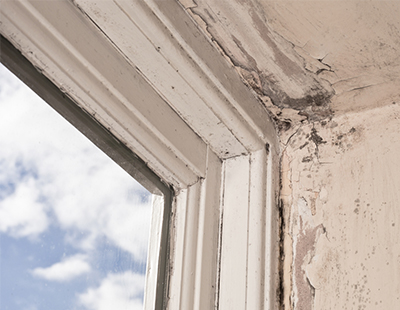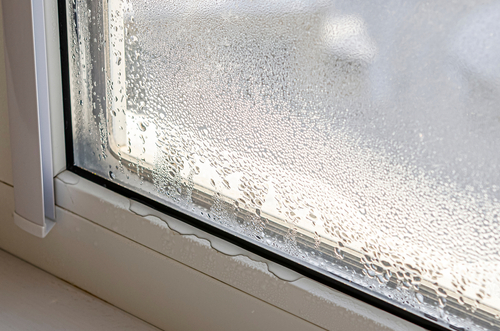As the dark nights draw in, condensation issues start to emerge, bringing with it the possibility of mildew and mould forming in homes across the UK.
When temperatures drop outside, it reduces the temperature of the externals walls of our homes and generates environments favourable to condensation, causing water droplets to form where air does not freely circulate.
This creates damp conditions that allow mildew and mould to thrive, leading to the deterioration in the decorative condition of the property, stained curtains, damaged fabrics, decay in window frames and potentially an unpleasant damp smell within the property.
To help householders deal with the issue, national trade body the Property Care Association (PCA) has put together some quick tips, which can make an immediate impact to reduce the presence of condensation.
James Berry, Deputy Chief Executive of the Property Care Association (PCA), said: “Issues with condensation and mould are usually more apparent in winter as the external air temperature is low.
“Mould is often the first indication that there is an issue with high humidity but condensation can present itself as water running down internal surfaces, leading to staining, peeling decoration and rot.
“Heating rooms to keep them dry is one way to try and avoid mould developing, but this isn’t always an affordable option, especially for anyone struggling to pay their heating bills.
“There are a few easy adjustments to avoid condensation issues in the first place that can help householders ensure their home is healthy space to live in.”
The PCA advice includes:
- Dry clothes outside wherever possible
- Run cold water in the bath before hot (which can reduce steam by 90 per cent). For showers. open the bathroom window a little and keep the bathroom door shut whilst in there, keeping it closed until the steam has gone.
- Clean and service fans and vacuum the dust out of window vents.
- Open windows and exterior doors to allow excess moisture to escape whenever its sensible to do so.
- Put lids on pans and turn the heat down once the water has boiled. This saves energy and reduces water getting into the atmosphere.
James added: “The most effective measure is efficient ventilation, coupled with having a low background heat for as long as you can, which helps to balance interior and exterior temperatures and reduces the likelihood of condensation forming when the heating comes on.
“Short intense bursts of heat in one room aren’t an effective use of energy.
“However, despite taking preventative measures, sometimes condensation issues will still persist, which may indicate a deeper problem.
“In this case we recommend sourcing a specialist surveyor to explore the cause of the problem and provide advice or propose solutions.”
The PCA has a free publication, ‘A homeowners guide to condensation in your property’ available at https://bit.ly/3fXNG4a which contains information to help manage the situation.
Want to comment on this story? Our focus is on providing a platform for you to share your insights and views and we welcome contributions.
If any post is considered to victimise, harass, degrade or intimidate an individual or group of individuals, then the post may be deleted and the individual immediately banned from posting in future.
Please help us by reporting comments you consider to be unduly offensive so we can review and take action if necessary. Thank you.



.jpg)











.jpg)






%20(002).png)



.jpg)
.jpg)






Join the conversation
Jump to latest comment and add your reply
Modern two bed EPC "B" flat with gas central heating. Never had a problem in 16 years. Young couple move in. First winter. No problems. Following Spring baby arrives. This year ( October onwards) big condensation problem. Despite being told to ventilate the property and not dry baby clothes in all rooms of the flat, ( they have a washer dryer but don't use it " cus it costs too much dunnit" ) wipe down surfaces etc- the problem persists. Provide dehumidifiers etc etc- won't use them as they " cost too much to run"
Contractor has been and said it's down to lifestyle.
Now been reported to council for " disrepair" by tenant. Nurse! Nurse!!!
Awaiting council visit - who have said not to do anything until they have been and assessed the situation.
If it goes the way I think it will then they may be on the move.....
I am with them on tumble driers but dehumidifiers cost pennies to run! You can't help some people!
James Berry teaches granny how to suck eggs.
He should try teaching tenants instead.
Well nothing thefe I didn’t know . Annoyed . Very True. But as we all know some or most tenants dont want to know. Or can’t read!😁
I gave my tenants a simplified version of the homeowners guide, translated into plain English clear instructions after remediating the first room they had allowed to become "infested" with mould. They then moved into the other bedroom, let that get just as bad, and told the council they had to leave due to the risk to their health. Sad thing is that they could have heated the whole flat to a reasonable level using the super efficient gas central heating system for less than it cost to just heat the living room with a portable electric heater. Full instructions on how the heating system worked were supplied at the start of the tenancy. Windows unopened, outdoor drying facilities unused and fully functional extractor over the uncovered pans on the cooker also unused.
At what point does it become the tenants responsibility to use the facilities provided??
No mention of PIV’s ie positive input ventilation systems. Sorted condensation issues in two of my properties no problem and they only cost a few hundred quid.
Please login to comment